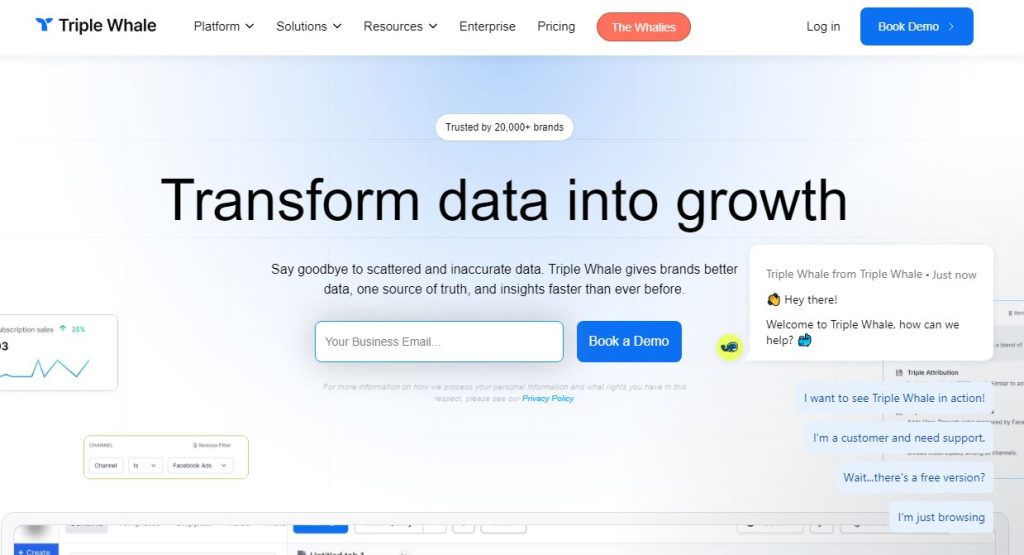In this Triple Whale review, we’ll take a deep dive into this powerful analytics platform designed to optimize marketing performance for eCommerce businesses. Whether you’re a small startup or a scaling enterprise, Triple Whale offers essential features like realtime data tracking, attribution modeling, A/B testing, and indepth audience analysis. By leveraging these tools, eCommerce business owners can streamline their marketing efforts, enhance customer targeting, and ultimately increase sales.
Quick Summary
- What Triple Whale Is: A comprehensive marketing analytics tool designed specifically for eCommerce businesses to track performance, optimize campaigns, and improve conversions.
- Key Features: Realtime tracking, attribution modeling, A/B testing, conversion tracking, audience analysis, and user friendly interface.
- Pros: Easy to use interface, robust tracking features, valuable insights into traffic sources and audience behavior.
- Cons: Higher pricing for smaller businesses, learning curve for advanced features, limited support for niche platforms.
- Pricing Plans: Flexible plans that scale with your business needs.
- Alternatives: Consider tools like Hyros, ClickMagick, or Google Analytics for similar analytics capabilities.
What is Triple Whale?

Triple Whale is an analytics platform designed for eCommerce businesses to track marketing performance, optimize campaigns, and enhance conversions. The platform consolidates key data points from different advertising channels and integrates them into a single, easy to use interface. With features such as realtime data tracking, attribution modeling, and A/B testing, Triple Whale gives business owners valuable insights that can help improve marketing efficiency and drive better results.
By offering detailed analytics on customer journeys, ad spend, conversion tracking, and more, Triple Whale serves as a critical tool for eCommerce brands seeking data driven strategies to scale their businesses.
Triple Whale Key Features
1. Data Tracking & Analytics
Triple Whale provides robust data tracking for eCommerce businesses, allowing you to monitor key metrics such as sales, customer behavior, and campaign performance. This real time tracking helps you assess the effectiveness of your marketing campaigns and optimize them on the fly.
Real Time Data: Access up to the minute performance data across different marketing channels.
Customizable Reports: Tailor the reports to reflect the metrics most important to your business goals, such as customer lifetime value (CLV) or return on ad spend (ROAS).
2. RealTime Dashboard
The realtime dashboard of Triple Whale is central to its user experience. It offers a clear, intuitive view of essential data points, allowing eCommerce businesses to quickly assess the performance of their campaigns and make data driven decisions.
Comprehensive Overview: Track metrics like traffic, conversions, and revenue from different sources all in one place.
Interactive Features: Drill down into any metric to uncover deeper insights, making it easier to pinpoint issues and opportunities for improvement.
3. Attribution Modeling
Triple Whale’s attribution modeling feature is designed to provide a detailed picture of how each marketing touchpoint influences conversions. With multiple attribution models available, you can track the effectiveness of ads, emails, social media, and other channels in driving sales.
Track Customer Journeys: Understand the path customers take across multiple channels before making a purchase.
Optimize Ad Spend: Use attribution insights to adjust your marketing strategy and spend more efficiently on the most profitable channels.
4. A/B Testing
A/B testing is a powerful feature in Triple Whale that allows businesses to test different versions of their ads, landing pages, or campaigns to determine which performs best. This feature is particularly useful for optimizing conversion rates and improving ad effectiveness.
Test Variations: Experiment with different designs, messaging, or strategies to find the best performing options.
Data Driven Decisions: Make adjustments based on real test results rather than assumptions or intuition.
5. Conversion Tracking
One of the most important aspects of any marketing strategy is understanding how well it converts visitors into customers. Triple Whale provides robust conversion tracking tools to measure the effectiveness of your campaigns.
Track Conversions Across Channels: See which campaigns and channels are driving the most sales and conversions.
Detailed Conversion Insights: Gain insights into what factors contribute most to conversions, such as customer demographics, ad types, and engagement patterns.
6. Audience and Traffic Source Analysis
Triple Whale offers powerful tools for analyzing audience behavior and identifying the most effective traffic sources. By understanding who your customers are and where they come from, you can optimize your marketing campaigns to reach the right people at the right time.
Audience Segmentation: Gain insights into customer demographics and behaviors, such as age, gender, location, and purchasing habits.
Traffic Source Breakdown: See which traffic sources (paid ads, organic search, social media, etc.) are generating the most conversions, allowing for better decision making regarding where to allocate your marketing budget.
7. User Interface and Experience
Triple Whale is designed with ease of use in mind, making it accessible for eCommerce businesses regardless of their technical expertise. Its clean and intuitive interface ensures that even users with minimal data analysis experience can navigate the platform effectively.
User Friendly Design: The platform is visually appealing and easy to navigate, reducing the time it takes to learn how to use its features.
Customizable Views: Tailor the dashboard to your preferences, allowing for a personalized user experience that focuses on the metrics that matter most.
8. Integration with Platforms
Triple Whale integrates with several major eCommerce and marketing platforms, allowing businesses to consolidate their data across multiple sources. Popular integrations include Shopify, Facebook Ads, Google Analytics, and more.
Seamless Integrations: Connect your eCommerce store and advertising platforms effortlessly for better data flow.
Automatic Data Syncing: Eliminate manual data entry as Triple Whale automatically pulls data from integrated platforms.
How Triple Whale Helps eCommerce Businesses
Triple Whale is a gamechanger for eCommerce businesses, offering tools that help optimize marketing efforts and improve overall performance:
Optimize Ad Spend: With attribution modeling, conversion tracking, and A/B testing, you can finetune your advertising strategies and allocate budget to the most profitable channels.
Better Customer Targeting: By analyzing audience behavior and traffic sources, businesses can create highly targeted campaigns that are more likely to convert.
Increase Conversions: The combination of realtime data tracking and indepth insights into the customer journey makes it easier to identify bottlenecks and improve conversion rates.
Triple Whale Pros and Cons
Pros
- Comprehensive Analytics: Triple Whale offers a wide range of tools for tracking every aspect of your marketing performance, from traffic and conversions to audience behavior and attribution.
- A/B Testing: This feature allows you to optimize campaigns and ads for maximum conversion.
- EasytoUse Interface: The platform is designed for business owners of all technical levels, with a user friendly interface that simplifies data analysis.
- Supports Multiple Platforms: Triple Whale integrates with popular eCommerce and advertising platforms, making it easier to manage and analyze data.
- Integrations with Major Platforms: The ability to sync data from eCommerce and advertising platforms like Shopify, Google Analytics, and Facebook Ads makes Triple Whale an efficient central hub for marketing analytics.
Cons
- Pricing: For smaller businesses or startups, the cost of Triple Whale may be prohibitive, especially when compared to other analytics platforms.
- Learning Curve: While the platform is user friendly, there may still be a learning curve when trying to maximize the potential of more advanced features.
- Niche Platform Support: Triple Whale is optimized for major eCommerce platforms, so if you’re using a more niche platform, you might find integrations or support lacking.
Triple Whale Pricing Plans
Triple Whale offers several pricing tiers, designed to scale with your business as it grows. Pricing is typically based on the number of integrations, features, and data points required.
Growth Plan
Price: Starts at $129
Features
Dashboard
Pixel
Anomaly detection
Postpurchase survey
Affluencer Hub
Web Analytics
Benchmarks
Mobile app
Live chat
Implementation support
Ideal for small businesses or those just getting started with analytics, offering basic tracking features and limited integrations.
Pro Plan
Price: starts at $199
Features
Everything in Growth, plus:
AI powered recommendations
RFM audiences
Activity feed
Cart analysis
Customer data platform
Cohort analysis
60/90 day LTV analysis
Dedicated CSM
For growing businesses that require more advanced tracking, reporting, and A/B testing capabilities.
Enterprise Plan
Price: Starts at $299 per month
Features
Everything in Pro, plus:
Creative Cockpit
Product analytics
Summary and attribution dataout APIs
Dedicated enterprise CMS
Strategic QBRs with an ecommerce growth strategist
Best suited for large businesses with complex needs, offering advanced features and dedicated support.
Custom pricing is available for the Enterprise plan, so businesses can reach out to Triple Whale for a tailored quote.
How to Get Started with Triple Whale
Getting started with Triple Whale is simple and straightforward:
1. Sign Up: Create an account by visiting the Triple Whale website.
2. Integrate Platforms: Connect your eCommerce platforms (e.g., Shopify) and marketing tools (e.g., Facebook Ads, Google Ads, Google Analytics etc).
3. Customize Dashboard: Choose which metrics are most important to you and customize your dashboard accordingly.
4. Monitor & Optimize: Use realtime tracking, A/B testing, and audience analysis to optimize your campaigns for better results.
Customer Support & Resources
Triple Whale provides robust customer support to help users get the most out of the platform:
Live Chat: Get immediate help via live chat for quick questions or issues.
Email Support: For more indepth issues, you can reach out to their support team via email.
Knowledge Base: Access a library of articles, guides, and tutorials to learn how to navigate and utilize the platform effectively.
Community Forum: Engage with other users through forums and user groups to share tips and strategies.
Alternatives to Triple Whale
Although Triple Whale is an excellent choice for eCommerce businesses, there are other tools worth considering:
Hyros: A competitive platform with advanced tracking and attribution features, suitable for scaling businesses.
ClickMagick: Known for tracking clicks, conversions, and sales, but it is less eCommerce focused compared to Triple Whale.
Google Analytics: A free tool with basic analytics, but lacks the specialized features like attribution modeling and A/B testing that Triple Whale offers.
Conclusion
Triple Whale is an invaluable tool for eCommerce businesses looking to enhance their marketing performance. With features like realtime tracking, A/B testing, attribution modeling, and audience analysis, it provides the insights necessary to make data driven decisions that drive growth. While it may not be the most cost effective option for small businesses, its robust features make it well worth considering for growing and large eCommerce brands.
If you’re serious about optimizing your eCommerce marketing and improving conversions, Triple Whale is a highly recommended platform.

